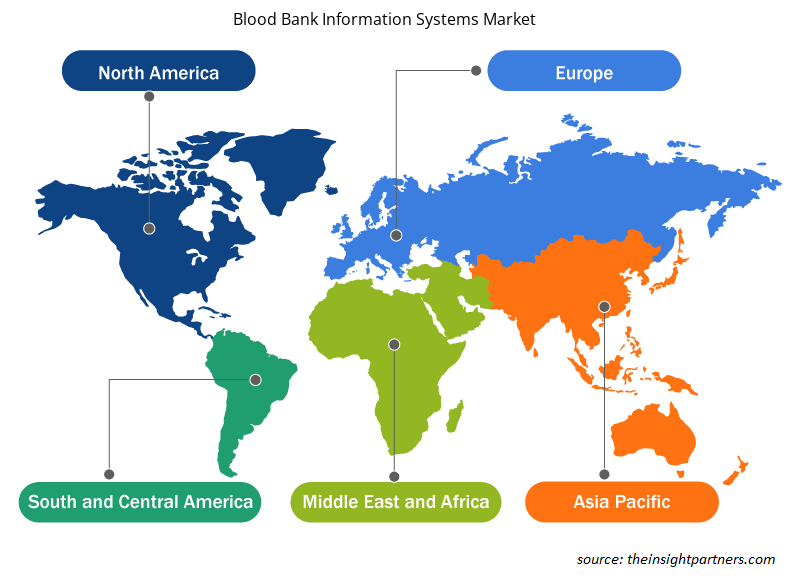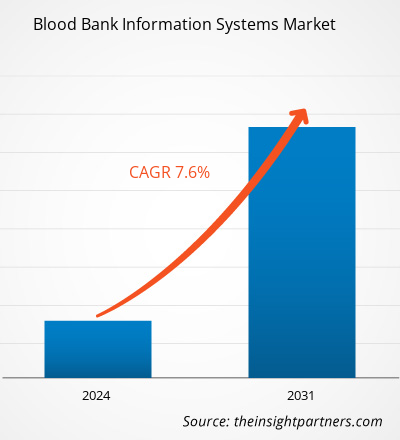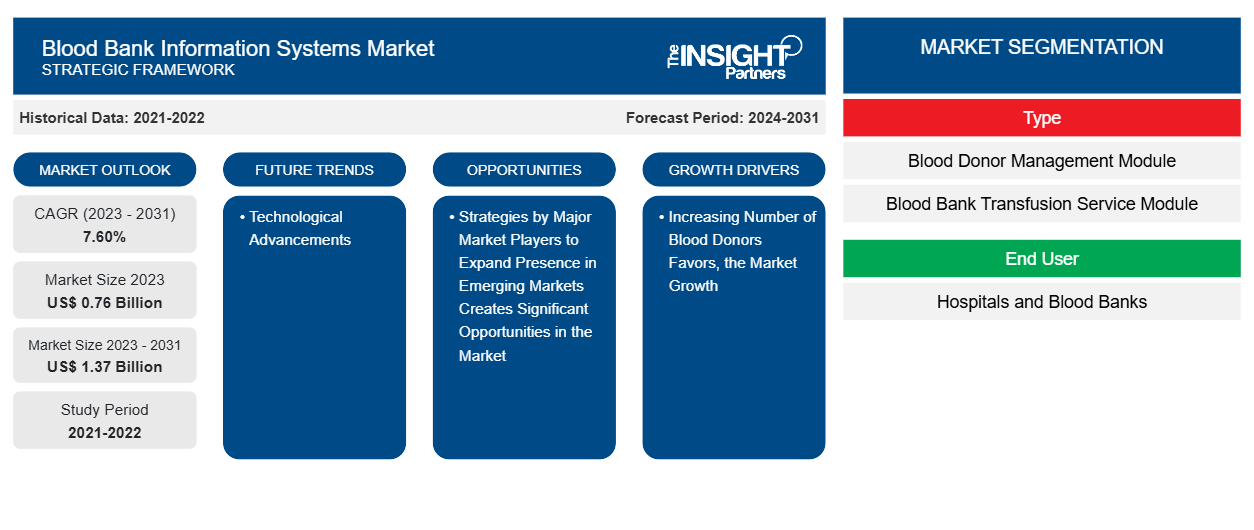Si prevede che la dimensione del mercato dei sistemi informativi delle banche del sangue raggiungerà 1,37 miliardi di dollari entro il 2031 da 0,76 miliardi di dollari nel 2023. Si prevede che il mercato registrerà un CAGR del 7,60% nel periodo 2023-2031. È probabile che il progresso tecnologico rimanga una tendenza chiave nel mercato.CAGR of 7.60% during 2023–2031. Technological advancement is likely to remain a key trend in the market.
Analisi di mercato dei sistemi informativi delle banche del sangue
Le aziende si sforzano di introdurre nuovi beni e aumentare le loro operazioni attraverso vari metodi dovrebbe stimolare il mercato. Aziende come Cerner Corporation, Allscripts Healthcare, LLC, Haemonetics Corporation, WellSky, Hemosoft, Integrated Medical Systems, Soft Computer Consultants, Inc., IT Synergistics, Psyche Systems Corporation e Sunquest Information Systems, Inc. hanno implementato una varietà di strategie, tra cui lanci di prodotti, approvazioni di prodotti, fusioni e acquisizioni e iniziative di mercato. Ad esempio, CliniSys ha annunciato a gennaio 2022 di aver recentemente acquisito HORIZON Lab Systems e di essersi unita a Sunquest Information Systems per diventare CliniSys.
Panoramica del mercato dei sistemi informativi delle banche del sangue
L'aumento della prevalenza globale di malattie ematologiche fa aumentare la domanda di donazioni di sangue. Ogni tre minuti, negli Stati Uniti, a una persona viene diagnosticata una leucemia, un linfoma o un mieloma, secondo la Leukemia and Lymphoma Society (LLS). Inoltre, nel 2021, sono stati segnalati negli Stati Uniti circa 186.400 casi di leucemia, linfoma e mieloma. Inoltre, nel 2021, i casi di cancro del sangue hanno rappresentato circa il 9,8% dei 1.898.160 nuovi casi di cancro stimati nella nazione. I trapianti di cellule del midollo osseo e le trasfusioni di sangue stanno diventando sempre più comuni a causa della crescente incidenza di tumori del sangue come la leucemia. La Croce Rossa americana stima che ogni giorno negli Stati Uniti siano necessarie circa 5.000 piastrine, 6.500 unità di plasma e circa 29.000 unità di sangue rosso per vari disturbi ematologici.
Inoltre, negli Stati Uniti vengono trasfusi annualmente 16 milioni di componenti del sangue per curare varie malattie legate al sangue, come il cancro del sangue e altre. Inoltre, è stato segnalato che nel 2020, oltre 1,8 milioni di individui hanno ricevuto una diagnosi di cancro. Di conseguenza, la necessità di trasfusioni di sangue è in aumento a causa dell'aumento delle malattie ematologiche, guidando la crescita del mercato globale dei sistemi informativi delle banche del sangue.
Personalizza questo report in base alle tue esigenze
Riceverai la personalizzazione gratuita di qualsiasi report, comprese parti di questo report, o analisi a livello nazionale, pacchetto dati Excel, oltre a usufruire di grandi offerte e sconti per start-up e università
-
Scopri le principali tendenze di mercato in questo rapporto.Questo campione GRATUITO includerà analisi di dati che spaziano dalle tendenze di mercato alle stime e alle previsioni.
Driver e opportunità del mercato dei sistemi informativi delle banche del sangue
L'aumento del numero di donatori di sangue favorisce la crescita del mercato
A causa dell'aumentata frequenza degli incidenti e della crescente prevalenza di malattie ematologiche, c'è una crescente domanda globale di sangue. L'Organizzazione Mondiale della Sanità (OMS) stima che circa 118,4 milioni di unità di sangue siano donate in tutto il mondo. Di queste, le nazioni ad alto reddito raccolgono il 40% del sangue. Inoltre, 106 milioni di donazioni vengono segnalate ogni anno da circa 13.300 banche del sangue distribuite in 169 paesi. Inoltre, secondo l'OMS, il 33% dei donatori di sangue in tutto il mondo sono donne.
Inoltre, l'OMS ha segnalato che tra il 2013 e il 2018, 156 paesi hanno segnalato un aumento di 7,8 milioni di donazioni di sangue volontarie non retribuite. Le regioni con gli aumenti più significativi nelle donazioni di sangue volontarie in sospeso sono l'Africa (23%) e le Americhe (25%). Il Pacifico occidentale ha segnalato l'aumento più significativo nei numeri assoluti delle donazioni (2,67 milioni), seguito dalle Americhe (2,66 milioni) e dal Sud-Est asiatico (2,37 milioni). Inoltre, le donazioni di sangue volontarie non retribuite rappresentano oltre il 90% della fornitura di sangue in circa 79 paesi, comprendenti 38 paesi ad alto reddito, 33 paesi a medio reddito e otto paesi a basso reddito. Inoltre, 62 nazioni ottengono la loro fornitura di sangue da donatori volontari e non retribuiti.
Inoltre, più della metà della fornitura mondiale di sangue (56 nazioni, nove nazioni ad alto reddito, 37 nazioni a medio reddito e 10 nazioni a basso reddito) dipende da donatori pagati e familiari. Ciò aumenta la necessità globale di sistemi informativi per le banche del sangue. Con l'aumento dei donatori di sangue in tutto il mondo, le banche del sangue gestiscono e conservano il sangue in modi nuovi e innovativi. I sistemi informativi per le banche del sangue vengono utilizzati principalmente per raccogliere le donazioni di sangue. Ad esempio, nel 2020 Samson Oloruntoba e altri editori hanno pubblicato un rapporto sullo sviluppo di un sistema di recupero del sangue per aiutare a gestire i registri dei donatori di sangue e regolamentare la distribuzione del sangue negli ospedali pubblici. Il sistema offre ai registri dei donatori un rapido accesso ai referti medici in modo tempestivo, efficiente e riservato. Il suo fondamento è un sistema di inventario delle donazioni di sangue basato su Android e Web che enfatizza la riduzione degli errori di trasfusione. Questi elementi supportano l'espansione del mercato per i sistemi informativi per le banche del sangue.Oloruntoba and other publishers. The system offers donor records quick access to medical reports in a timely, efficient, and confidential manner. Its foundation is an Android- and web-based blood donation inventory system emphasizing lowering transfusion errors. These elements support the market expansion for blood bank information systems.
Le strategie dei principali attori del mercato per espandere la presenza nei mercati emergenti creano opportunità significative nel mercato
A causa del crescente numero di donatori di sangue in Asia-Pacifico e America Centrale e Meridionale, gli operatori del mercato dei sistemi informativi delle banche del sangue pianificano la loro crescita in più aree. Il deep learning ha dimostrato prestazioni promettenti nella gestione del sangue impiegando sistemi tradizionali di gestione dei donatori di sangue e moduli di servizi di trasfusione delle banche del sangue. Ultimamente, il sistema informativo delle banche del sangue ha attirato molta attenzione da parte della ricerca. Nei prossimi anni, si prevede che numerose aziende, tra cui WellSky, Sunset Information Systems, SCC Soft Computer's Blood Bank e Allscripts Healthcare Solutions, continueranno a espandersi in questi mercati in via di sviluppo attraverso fusioni, acquisizioni e alleanze strategiche. A giugno 2018, uno dei migliori ospedali pediatrici del Colorado ha utilizzato il software Mediware di WellSky per i servizi di gestione del sangue. Il software offre strumenti per supportare le procedure che garantiscono ai bambini la varietà di prodotti sanguigni di cui hanno bisogno. Gli ospedali hanno implementato tre soluzioni di gestione del sangue di Mediware, HCLL, LifeTrak e Trastem, per gestire la filiera del sangue. Psyche Systems Corporation, Cerner Corporation, Haemonetics Corporation, Hemosoft e altre aziende hanno stabilito offerte di servizi nel corso degli anni, indicando il loro posizionamento strategico nella regione. Durante tutto il periodo di proiezione, queste opportunità di mercato supporteranno l'espansione del sistema informativo delle banche del sangue.WellSky, Sunset Information Systems, SCC Soft Computer's Blood Bank, and Allscripts Healthcare Solutions—will keep expanding in these developing markets through mergers, acquisitions, and strategic alliances. In June 2018, one of the best pediatric hospitals in Colorado used WellSky's Mediware Software for blood management services. The software offers tools to support the procedures that guarantee kids get the variety of blood products they require. The hospitals implemented three blood management solutions from Mediware—HCLL, LifeTrak, and Trastem—to handle the blood supply chain. Psyche Systems Corporation, Cerner Corporation, Haemonetics Corporation, Hemosoft, and other companies have established service offerings over the years, indicating their strategic positioning in the region. Throughout the projection period, these market opportunities will support the expansion of the blood bank information system.
Analisi della segmentazione del rapporto di mercato sui sistemi informativi delle banche del sangue
I segmenti chiave che hanno contribuito alla derivazione dell'analisi di mercato dei sistemi informativi delle banche del sangue sono la tipologia e l'utente finale.
- In base al tipo, il mercato dei sistemi informativi delle banche del sangue è segmentato in moduli di gestione dei donatori di sangue, moduli di servizio di trasfusione delle banche del sangue e altri. Il segmento dei moduli di gestione dei donatori di sangue ha detenuto la quota di mercato più significativa nel 2023.
- In base all'utente finale, il mercato è segmentato in ospedali e banche del sangue. Il segmento ospedaliero ha detenuto una quota significativa del mercato nel 2023.
Analisi della quota di mercato dei sistemi informativi delle banche del sangue per area geografica
L'ambito geografico del rapporto sul mercato dei sistemi informativi delle banche del sangue è suddiviso principalmente in cinque regioni: Nord America, Asia Pacifico, Europa, Medio Oriente e Africa, e Sud e Centro America.
Il mercato dei sistemi informativi delle banche del sangue del Nord America è segmentato in Stati Uniti, Canada e Messico. Il Nord America domina il mercato mondiale dei sistemi informativi delle banche del sangue, che dovrebbe continuare nel periodo previsto. Si prevede che il Nord America avrà la quota di mercato maggiore durante il periodo di proiezione. Ciò è dovuto alla crescente necessità di trasfusioni di sangue sicure e al crescente numero di ospedali e banche del sangue nella regione. Questa espansione è stata anche favorita da una maggiore consapevolezza pubblica dell'importanza della donazione del sangue. Poiché gli Stati Uniti hanno un sistema di raccolta del sangue pluralistico, non esiste un archivio dati centrale sul numero di unità di sangue raccolte o sui componenti prodotti o trasfusi. La Croce Rossa Americana (ARC) raccoglie circa il 45 percento dei 14 milioni di unità di sangue intero disponibili ogni anno negli Stati Uniti. Altre banche del sangue comunitarie raccolgono circa il 42 percento, gli ospedali raccolgono circa l'11 percento e il restante 2 percento viene importato. Le banche del sangue ospedaliere devono disporre di un sistema informativo basato su computer per soddisfare i requisiti. Questo sistema semplifica la gestione delle banche del sangue e garantisce la sicurezza della conservazione, distribuzione e tracciabilità del sangue e dei suoi componenti. Consente la creazione di una cartella clinica per ogni paziente trasfuso, contenente le caratteristiche degli emocomponenti trasfusi e lo stato immunofarmacologico del paziente, ricevuta dall'istituto trasfusionale tramite scambio elettronico di dati.
Approfondimenti regionali sul mercato dei sistemi informativi delle banche del sangue
Le tendenze regionali e i fattori che influenzano il mercato dei sistemi informativi delle banche del sangue durante il periodo di previsione sono stati ampiamente spiegati dagli analisti di Insight Partners. Questa sezione discute anche i segmenti e la geografia del mercato dei sistemi informativi delle banche del sangue in Nord America, Europa, Asia Pacifico, Medio Oriente e Africa e Sud e Centro America.

- Ottieni i dati specifici regionali per il mercato dei sistemi informativi delle banche del sangue
Ambito del rapporto di mercato sui sistemi informativi delle banche del sangue
| Attributo del report | Dettagli |
|---|---|
| Dimensioni del mercato nel 2023 | 0,76 miliardi di dollari USA |
| Dimensioni del mercato entro il 2031 | 1,37 miliardi di dollari USA |
| CAGR globale (2023-2031) | 7,60% |
| Dati storici | 2021-2022 |
| Periodo di previsione | 2024-2031 |
| Segmenti coperti |
Per tipo
|
| Regioni e Paesi coperti |
America del Nord
|
| Leader di mercato e profili aziendali chiave |
|
Densità degli attori del mercato dei sistemi informativi delle banche del sangue: comprendere il suo impatto sulle dinamiche aziendali
Il mercato dei sistemi informativi delle banche del sangue sta crescendo rapidamente, spinto dalla crescente domanda degli utenti finali dovuta a fattori quali l'evoluzione delle preferenze dei consumatori, i progressi tecnologici e una maggiore consapevolezza dei benefici del prodotto. Con l'aumento della domanda, le aziende stanno ampliando le loro offerte, innovando per soddisfare le esigenze dei consumatori e capitalizzando sulle tendenze emergenti, il che alimenta ulteriormente la crescita del mercato.
La densità degli operatori di mercato si riferisce alla distribuzione di aziende o società che operano in un particolare mercato o settore. Indica quanti concorrenti (operatori di mercato) sono presenti in un dato spazio di mercato in relazione alle sue dimensioni o al valore di mercato totale.
Le principali aziende che operano nel mercato dei sistemi informativi delle banche del sangue sono:
- Emostatico
- Società Cerner
- Assistenza sanitaria Allscripts, LLC
- Società di emodinamica
- Sistemi medici integrati
- Consulenti informatici Soft, Inc.
Disclaimer : le aziende elencate sopra non sono classificate secondo un ordine particolare.

- Ottieni una panoramica dei principali attori del mercato dei sistemi informativi delle banche del sangue
Notizie di mercato e sviluppi recenti sui sistemi informativi delle banche del sangue
Il mercato dei sistemi informativi delle banche del sangue viene valutato raccogliendo dati qualitativi e quantitativi dopo la ricerca primaria e secondaria, che include importanti pubblicazioni aziendali, dati associativi e database. Di seguito sono elencati alcuni degli sviluppi nel mercato dei sistemi informativi delle banche del sangue:
- MAK-System, leader mondiale nei sistemi di gestione del sangue, è orgogliosa di annunciare una partnership estesa e strategica con New York Blood Center Enterprises (NYBCe). In base all'accordo, MAK-System gestirà la piattaforma MAK.care come servizio gestito, gestendo l'intero ecosistema digitale per conto di NYBCe. L'accordo decennale trasformerà il modo in cui il sangue viene gestito e consegnato ai pazienti sfruttando i vantaggi dei servizi gestiti. (Fonte: MAK-System, comunicato stampa, giugno 2023)
- CliniSys ha annunciato la recente acquisizione di HORIZON Lab Systems e la combinazione con Sunquest Information Systems come CliniSys. Questa acquisizione e la combinazione con Sunquest creano una delle più grandi organizzazioni al mondo dedicate all'informatica diagnostica e di laboratorio. (Fonte: Sunquest Information Systems, Inc., comunicato stampa, gennaio 2022)
Copertura e risultati del rapporto di mercato sui sistemi informativi delle banche del sangue
Il rapporto "Dimensioni e previsioni del mercato dei sistemi informativi delle banche del sangue (2021-2031)" fornisce un'analisi dettagliata del mercato che copre le seguenti aree:
- Dimensioni e previsioni del mercato dei sistemi informativi delle banche del sangue a livello globale, regionale e nazionale per tutti i principali segmenti di mercato coperti dall'ambito
- Tendenze del mercato dei sistemi informativi delle banche del sangue e dinamiche di mercato come fattori trainanti, limitazioni e opportunità chiave
- Analisi dettagliata delle cinque forze PEST/Porter e SWOT
- Analisi di mercato dei sistemi informativi delle banche del sangue che copre le principali tendenze del mercato, il quadro globale e regionale, i principali attori, le normative e i recenti sviluppi del mercato.
- Analisi del panorama industriale e della concorrenza che copre la concentrazione del mercato, l'analisi della mappa di calore, i principali attori e gli sviluppi recenti per il mercato dei sistemi informativi delle banche del sangue
- Profili aziendali dettagliati
- Analisi storica (2 anni), anno base, previsione (7 anni) con CAGR
- Analisi PEST e SWOT
- Valore/volume delle dimensioni del mercato - Globale, Regionale, Nazionale
- Industria e panorama competitivo
- Set di dati Excel
Report recenti
Rapporti correlati
Testimonianze
Motivo dell'acquisto
- Processo decisionale informato
- Comprensione delle dinamiche di mercato
- Analisi competitiva
- Analisi dei clienti
- Previsioni di mercato
- Mitigazione del rischio
- Pianificazione strategica
- Giustificazione degli investimenti
- Identificazione dei mercati emergenti
- Miglioramento delle strategie di marketing
- Aumento dell'efficienza operativa
- Allineamento alle tendenze normative























 Ottieni un campione gratuito per - Mercato dei sistemi informativi delle banche del sangue
Ottieni un campione gratuito per - Mercato dei sistemi informativi delle banche del sangue